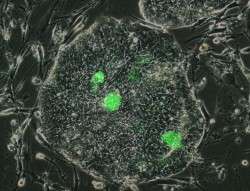Naive-like stem cells could potentially be used to treat dementia or reduce organ transplants
Scientists from our university and Berlin have identified a type of human stem cell that appears to be "naïve-like" – able to develop into any type of cell. The discovery of this cell type could potentially have a large impact on our understanding of how humans develop and on the field of regenerative medicine.
The human embryonic stem cells (ESCs) that scientists currently study in the lab are able to develop into several different types of cell but are already pre-determined to some extent.
Published in the top scientific journal Nature, researchers from the Max Delbrück Centre for Molecular Medicine (MDC), Berlin, Germany and our university have for the first time discovered human ESCs that appear to behave like "naïve" cells – able to develop into any type of cell.
These naïve-like cells, only previously found in mice, are easy to grow in the lab and could have huge potential for regenerating damaged tissues in the body, potentially leading to treatments for diseases such as dementia or reducing the need for organ transplantation.
Professor Laurence Hurst from our Department of Biology & Biochemistry and a co-author of the study explained: "Most stem cells are primed to some extent to become a certain type of cell. If you use the analogy of a train network, these cells are like one of the main London stations. Trains from Paddington can go to Cardiff or Exeter, but not to Norwich. In the same way, these cells can develop into a fixed number of different cell types.
"However the naïve-like cells we've identified are like a central terminus; they are present earlier in the embryo's development and so we think their fates can go in any direction and become any type of cell."
Co-investigator Dr Zsuzsanna Izsvák, (MDC, corresponding author) said: "We were very excited by this discovery – it was one of those Eureka moments that rarely happens in science."
The Bath and Berlin team found the naïve-like cells by looking at which genes were expressed in very early human embryos. They pinpointed a virus called human endogenous retrovirus H (HERVH) that has become integrated into human DNA and was very highly expressed at just the right time and place in human embryos, where they would expect to see naïve-like cells if they existed.
They identified a protein called LBP9, which is essential for the activity of HERVH in early embryos. Using a reporter system that made cells expressing HERVH via LBP9 glow green, the Berlin and our team found that they had purified cells that showed all of the hallmarks of a mouse naïve cell.
Jichang Wang (PhD student from MDC), first author of the Nature publication said: "Our human naïve-like cells look remarkably like the mouse ones, and express the same sorts of genes as the human inner cell mass (ICM) in the embryo, just as expected of naïve cells."
However, although, these cells are highly similar to naïve mouse embryonic stem cells, they have features that are unique to humans.
"As an evolutionary biologist, this is the aspect I find most curious," commented Professor Hurst. "One would expect that a mechanism as important as pluripotency would be conserved in different species of mammals," he pointed out.
Journal information: Nature
Provided by University of Bath




















